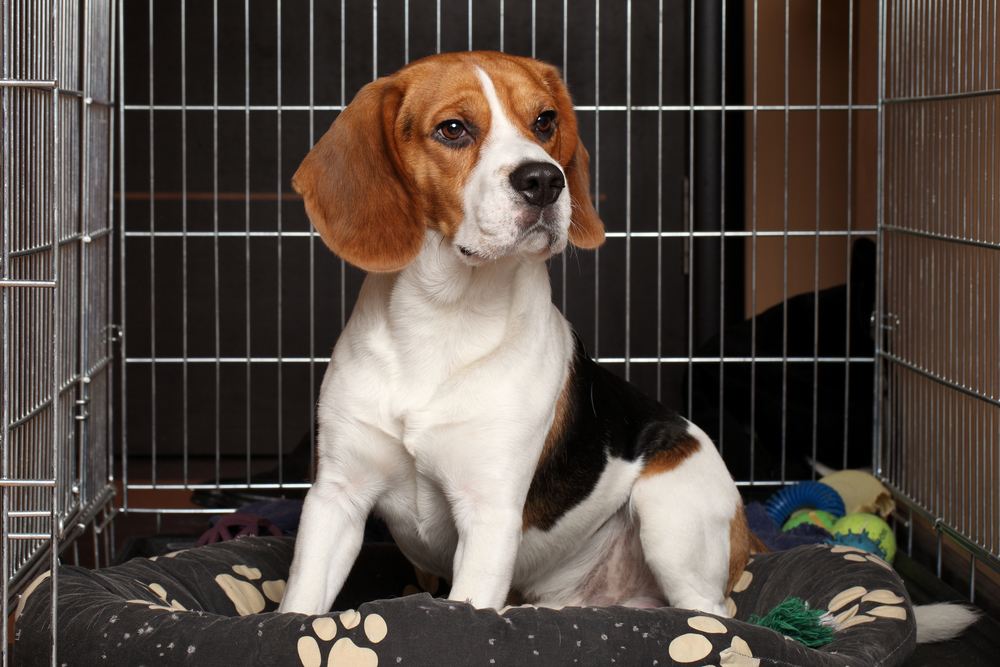- Male Dog Names: Game of Thrones Unofficial Guide
- How to Take Care of Your Dog: 8 Things Your Vet Wants You to Know
- A New Grump In Town- Grumpy Cat Meet Grumpy Dog
- Watch Out! The 8 Most Dangerous Household Items for Dogs You Might be Overlooking
- The 15 Most Embarrassed Dogs on Dress Up Your Pet Day
- Guaranteed Smile: You Won’t Believe How This Dog Greets Her Owner
- Dogs in Booties – Way More Fun Than You’d Expect
- 22 Naughtiest Dogs Confess Their Crimes
Should You Crate Train Your Dog?
We have previously written about types of dog beds and we know that it’s a great option for many dogs. Is a dog bed always best though? Not necessarily. Some dogs prefer to sleep in crates, and for housetraining purposes, crates may offer you benefits that a dog bed cannot.

Do Dogs Like Crates?
If you are a new dog owner, one of your first questions is probably why a dog would actually want to spend time in a crate. As human beings, we generally do not enjoy being confined. You might look at a crate and see a cage. But that probably is not what your dog sees. As the Humane Society describes it, a crate is a “Private room with a view. Ideal for traveling dogs or for those who just want a secure, quiet place to hang out at home.” In essence, a crate is very much like a den, and appeals to denning instincts. So yes, many dogs really do like crates!
Why Consider Crate Training?
What are the benefits of crate training your dog? Here are just a few:
- Crate training is a short-term tool, but the long-term benefits are huge, not just for you, but also for your dog. If dogs get uncomfortable because of thunderstorms or unexpected guests or other disturbances, they can flee to the refuge of their crates and feel safe.
- Crates are very handy for traveling. Your dog’s crate makes it easier and more comfortable to transport your dog on vacation (much better than the suitcase below– which is NOT recommended ;-)– as well as for short trips to friends’ houses, the veterinarian, and so on. The crate eliminates stress for your dog and also for you.

- Crate training can help you to housetrain a destructive dog and eliminate behavioral problems without the dog tearing apart the house. Your furniture, pillows, toys, and other household items can stay intact.
- Crate training is also great for toilet training. While many people consider this to be its primary use, it really is just the start of the advantages.
Important Precautions for Crate Training Your Dog
Crate training is a great tool when it is used appropriately. Used inappropriately however, crates can become cruel. Author and veterinarian Peter Wedderburn explains, “Teaching your dog to go to his crate on cue should never be used as a punisher, but as a positive experience for your pet and a valuable exercise for you.” Your goal is to make the crate into a positive place. Once housetraining is complete, your dog can still continue to voluntarily use the crate. It should ultimately become a safe place of refuge for a dog that is anxious or scared, or just wants a place to rest and relax.
What can you do if you do need a “time out” with your dog? Wedderburn suggests that you take your puppy to his crate for no more than two minutes. Hide some treats inside the bedding so that your pet has a nice surprise waiting for him. This will keep the time out from turning into a negative reinforcement. Your goal is always to make the crate training pleasant and enjoyable, even fun if possible.
Also important is to understand that the dog crate is there first and foremost for the benefit of your dog, not your benefit. While the crate does provide you with temporary convenience, it is not a cage to lock your animal into while you are away or busy for hours on end, and dogs should never be placed in a crate for longer than a safe period of time. Here are some guidelines:
- 8-10 weeks old: 30-60 minutes
- 11-14 weeks: 1-3 hours
- 15-16 weeks: 3-4 hours
- 17+ weeks: 4-5 hours
Do not place puppies in a crate if they are too young or cannot control their bladder or bowel movements. Dogs with diarrhea or vomiting problems should never be in a crate either. Always make sure your dog has eliminated before you place her in the crate. And never put a dog in a crate that is not getting sufficient exercise or socialization. If the temperature is really warm, it is also a bad idea to use the crate.
Are Crates Right For All Dogs?
While crate training is excellent for many puppies and even adult dogs, it is not ideal for every dog, and some dogs should never be crate-trained, especially those which suffer from anxiety (especially separation anxiety) or fear of confined spaces (perhaps because of a past trauma). “An occasional dog may not tolerate crate training,” writes Dr. Hanna Ekstrom, “and may continue to show anxiety, or even eliminate when confined.” Ekstrom suggests that these dogs be trained using pens, dog runs or small rooms instead. Some dogs will never take to crates, and that is okay. Your goal is to create a happy, safe, harmonious household environment. If a crate helps, then use it. If it does not, there are other options for housetraining your dog which will have better results.
Before you get started, be sure to do your research and learn step-by-step instructions for crate training success. The Humane Society provides excellent guidelines. These instructions will help you choose a crate and schedule training throughout the week.
Used correctly, a crate can be a great tool for short-term training, and also provide your dog with a long-term “den” where he can feel safe, protected, and at home. Once your dog is appropriately housetrained, the crate should only be a place where your dog goes voluntarily. Many dogs enjoy both dog beds and crates.

Crate training takes time and patience, but the benefits for you, and most importantly for your dog, can be well worth it!




